Adventure on the Vertical
Powers of Ten and the mastery of space by vision
Mark Dorrian
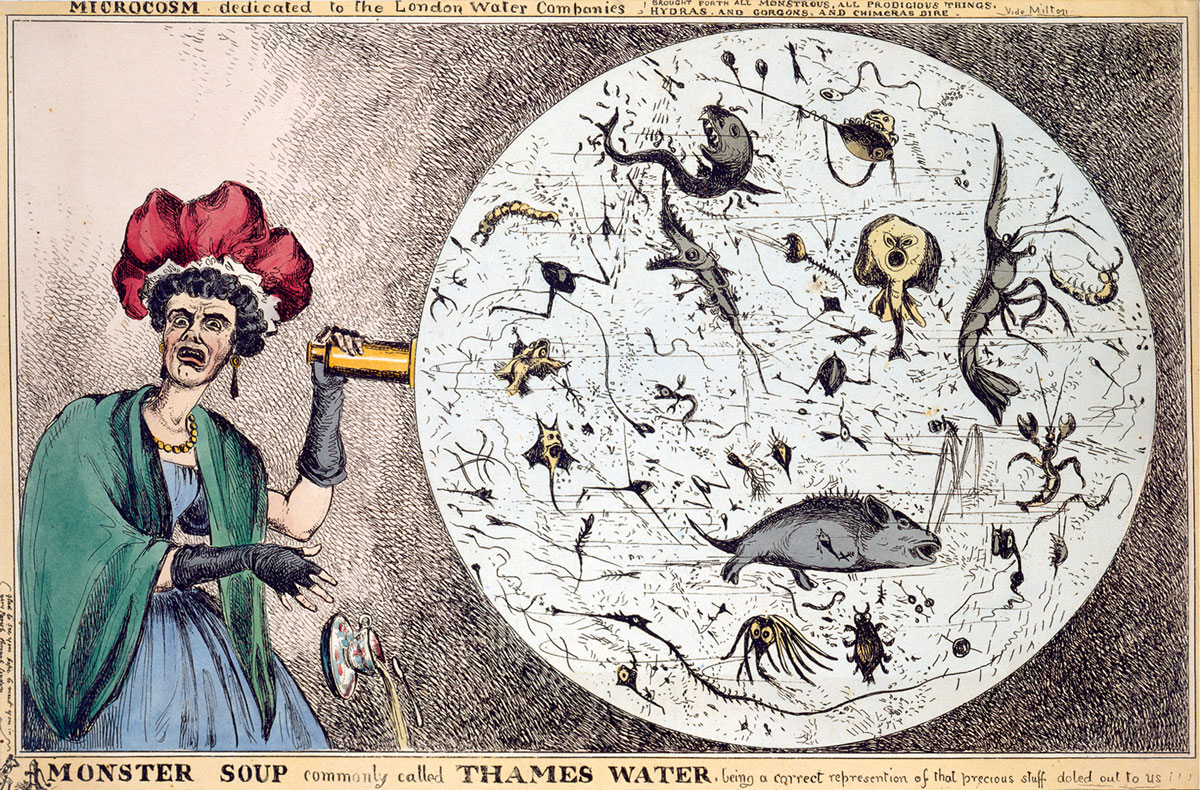
We are no longer so excited as formerly by the account of trips on the surface … The mind is stretched, uncomfortably sometimes, but with a new fascination, to speed and profundity, to the thought of worlds that lie a million light-years away from us, to the worlds that recede in evolutionary time beneath the lens, to the thought even that they merge or that by some extraordinary trick of relativity the smaller may contain the large. There is an affinity between the telescope and the microscope, between the discovery of stellar space and the discovery of the atom.[1]
Watson-Baker’s book on microphotography appeared as the second of two volumes inaugurating a new series launched by The Studio publishing house under the rubric of “The New Vision.” Like its companion volume, Le Corbusier’s Aircraft, it was very much a meditation on seeing from above, a reflection on the affective and epistemic dimensions of looking downward. Gaunt’s announcement of cultural boredom with the horizontal, and the corresponding reorientation of attention onto the vertical, invoked the notion that the view from above—together with its associated technologies—formed a peculiarly modern visual form. His richly articulated introduction certainly looked back to earlier arguments regarding elevated vision, but at the same time it presciently anticipated future expressions of the new adventure on the vertical, perhaps the most striking of which would be Charles and Ray Eames’s short film Powers of Ten.
Gaunt’s text is a useful starting point, however, for it alerts us to the kinds of imagined relation with things that were fostered by technologies of seeing from above. The diminishment of enormity through the elevation of vision (as from, for example, an aircraft), or the magnification of the miniscule through the microscope, permitted things of radically different scales to enter into new kinds of imaginative transaction with one another, reactivating ideas of micro-macro correspondence, albeit on new terms. Here I want to emphasize one of these, or rather a complex that develops around one: that is, the notion that what is glimpsed through the microscope is another “world,” an idea reinforced by the planetary associations of the circular frame of the instrument’s scopic field. This is an allusion that has long attended our experience of the microscope, and it is hinted at in the ambiguous title of Watson-Baker’s book (is it this world, or another, that we see when we look through the eyepiece?) In his Thoughts on Animacules of 1846, Gideon Mantell had written “the air, the earth, and the waters teem with numberless myriads of creatures, which are as unknown and as unapproachable to the great mass of mankind, as are the inhabitants of another planet,” while William Heath’s famous 1820s satirical engraving, Monster Soup, playing upon the then popular solar microscope shows, characterized a magnified drop of London tap water as a frightful microcosm populated with bizarre creatures arrayed within the circular planet-like frame in a manner reminiscent of earlier emblematic depictions of star constellations.[2] At the same time, this idea of the microscope as opening onto another world stimulates dreams of travel, exploration, and perhaps even conquest of the strange alien landscape, whether the voyager might be imagined as a submariner plunging into the microscopic depths or a planetary explorer—or perhaps even both simultaneously.[3] And this, in turn, provokes fantasies of miniaturization, to which we shall shortly return.

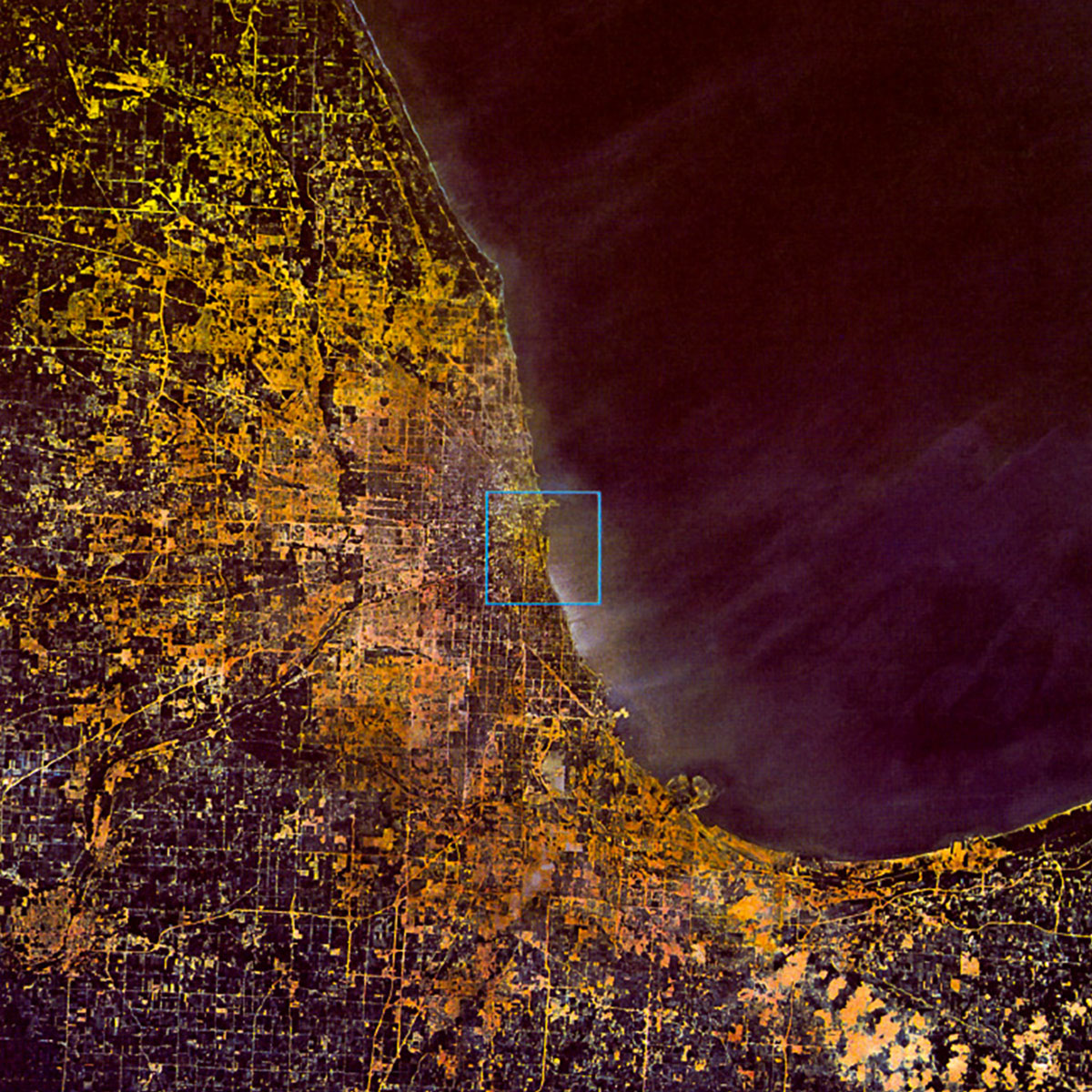

Powers of Ten was originally inspired by a 1957 book by the Dutch educator Kees Boeke titled Cosmic View. By 1963, the Eameses were experimenting with tracking shots that gave the effect of a camera pulling away with accelerating motion from an object, and in 1968 used these in a film called A Rough Sketch for a Proposed Film Dealing with the Powers of Ten and the Relative Size of Things in the Universe. Shot in black and white, it was followed by an extended color version—the one known as Powers of Ten—made in 1977. The basic set-up of the latter film is well-known. It opens with a picnic scene in a park in Chicago. From a ground level view, the camera then switches to a vertical, aerial position from which it looks down, the frame centered—as we later find out—on an atom in the man’s hand. At this point the narrator tells us that we are one meter away and looking at a square one meter by one meter. Now the camera pulls away vertically and begins to accelerate so that every ten seconds our distance from the initial scene is ten times greater. The camera continues its upward trajectory until just after 1024 meters (100 million light years) when it gradually slows and begins its descent, collapsing beyond its original position and now decelerating through the ever-smaller dimensions of cells, molecules, atoms, and beyond.
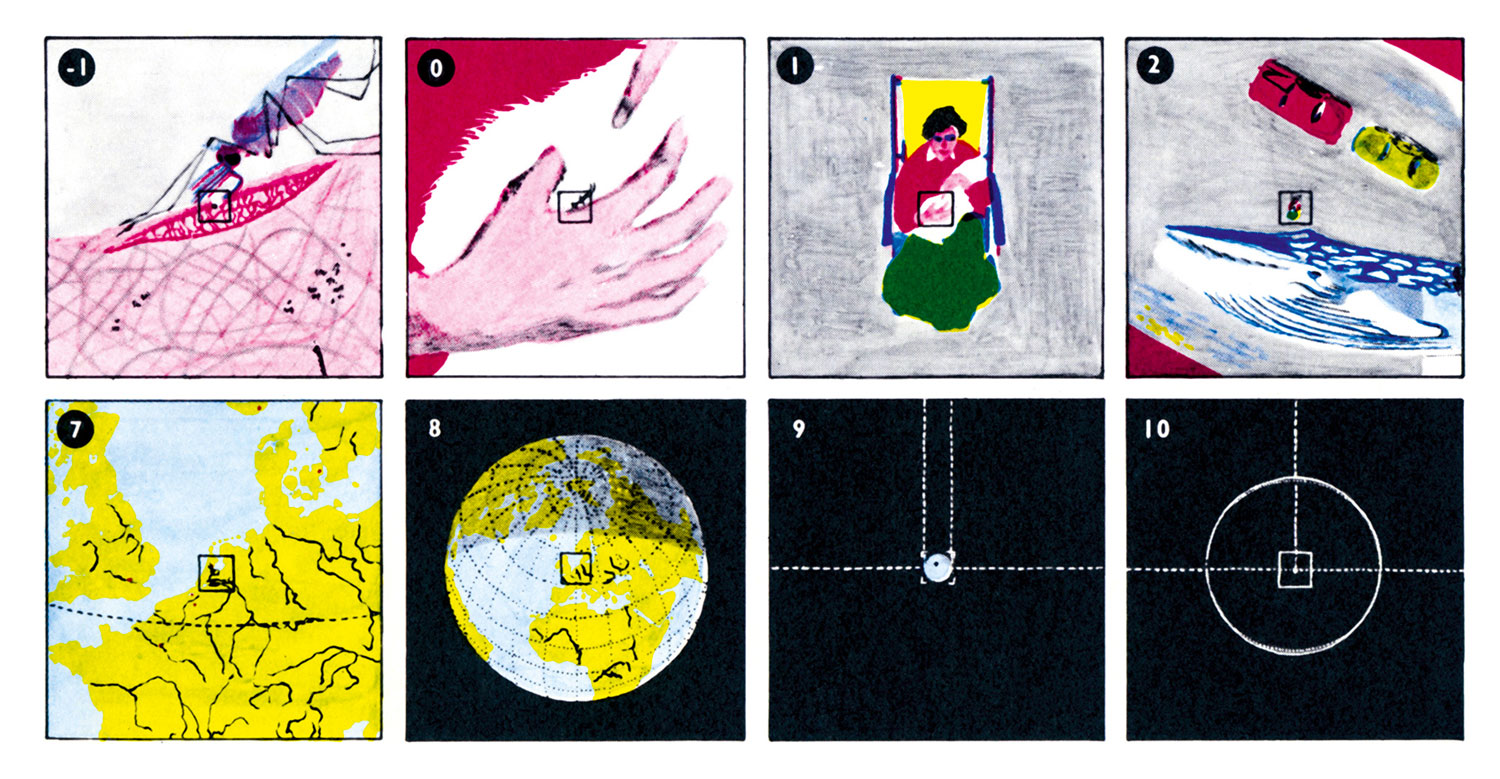
While Powers of Ten seems more about magnification and resolution than mobility, commentaries have tended to dwell on the visceral (that word is often used) sense of travel it provokes. This is especially pronounced in Rough Sketch, in which the left-hand margin of the screen is occupied by twin chronometers—like dials on a dashboard—one counting out the time at origin and the other the “traveler’s time,” the latter slowing in relation to the former as the voyager increases velocity. The rocket-like set-up is further emphasized by the fact that in this version we are launched from Florida, the emblematic point of departure for the Apollo missions. Philip Morrison, who consulted for the 1977 version and narrated the script, compared the feeling the film engendered to being “like a driver in a space ship” while in his 1970 essay for Film Quarterly, “Poetry of Ideas,” Paul Schrader wrote of “the time-space traveler” of the Rough Sketch.[7] What is particularly notable is the uncanny feeling of symmetry that the film conveys, with the journey outward into space (and surely it is not by chance that we go in this direction first) then being mirrored as we pass into—and voyage through—the microscopic scales of inner space, which are revealed to be so visually consonant with their counterparts. And this in turn endows the film with a strange circularity, almost as if the poles of the vertical line along which we have passed were bent to meet one another.
Turning to the book on which the man’s left hand rests we find that it is not, as we might expect, Kees Boeke’s Cosmic View, but rather The Voices of Time, a 1966 collection of essays edited by the Hungarian-American physicist and social scientist Julius Thomas Fraser. And here we perhaps detect an echo of a book that was published in the US four years earlier, namely J. G. Ballard’s The Voices of Time and Other Stories. The title story in Ballard’s collection tells of a scientist (curiously named Powers) who is slowly going to sleep, victim of a “narcoma syndrome” to which increasing numbers are succumbing. There is not space to describe the story in detail here, or—in Powers’s words—the “monstrous surrealist” future it envisages, save to say that it concludes with the scientist lying in the center of a mandala that he has obsessively constructed, perhaps indeed a mandala like the one reproduced on the cover of Fraser’s book, upon which the hand of our sleeping picnicker rests. As Powers falls asleep, his consciousness dissolves into the universe’s great stream of radiation: “Above him he could hear the stars, a million cosmic voices … Like jostling radio beacons … To Powers the sky seemed an endless babel, the time-song of a thousand galaxies overlaying each other in his mind.”[8] Notably, when the story was published in Britain in 1963, it appeared in a collection titled The 4-Dimensional Nightmare.
So what might this mean for the way we read Powers of Ten? Beyond its ostensibly educational function, the film does two somewhat contrasting things. Firstly, insofar as it is a dream sequence—a monstrous sleep of reason or perhaps even a “4-dimensional nightmare”—it pictures a kind of vertiginous, abyssal collapse of the everyday reality with which the film begins. Note, for example, Alan Lightman’s characterization of the film: “We feel dizzy and overwhelmed. Suddenly the camera begins compressing, shrinking in powers of ten: we fly through galaxies, solar systems, planets, are back in our park, back to the familiar and the comfortable. We want to stop here and recuperate in the warm sun, but the camera won’t let us, it keeps galloping to smaller and smaller scales: to microscopic tissues, molecules, atoms, the interior of atoms, and we see the unknown grinning at us from this side as well. The unknown has surrounded us. The world of the everyday seems now like an illusion.”[9]
On the other hand, when seen in the Cold War corporate and national context in which it was conceived and developed, Powers of Ten—with its visual rhetoric of voyaging through scales, across outer and inner space, aimed ultimately at the core of the atom—might also be read in terms of the domination and control of the realms that it pictures. If we are—at least at the time of Rough Sketch—in the midst of the “space race,” then the films seem to picture its extension into the inner space of the body and the microscopic. Here we can appreciate why it is important that we should first go outward. Moving away from the earth prepares the analogy and sets up the structural relation between the two domains: for only when we have first been in outer space, with all its connotations, are we then predisposed to understand the microscopic, or the interior of the body, as inner space. Likewise, through the sequential staging of “outer” and “inner” in the films, we develop the sense of a narrative unfolding, a plot-like effect that emerges from the structural relation that organizes them.[10] The abilities to represent and to manipulate the microscopic go hand-in-hand, and the effort to extend sovereignty over small things has a long history. Robert Hooke’s Micrographia (1665), for example, is dedicated to the king, whose empire extends (and is extended by this book of minutiae) over “invisible things,” the best of which are “the minds of men.”[11] It is surely important that the commissioning background for so much of the Eameses’ work involved such a geopolitically symbolic corporation as IBM, whose manufacturing was focused on electronic computational and informational devices that were predicated upon an ability to intervene in and command the microscopic and even subatomic world that the films expounded.
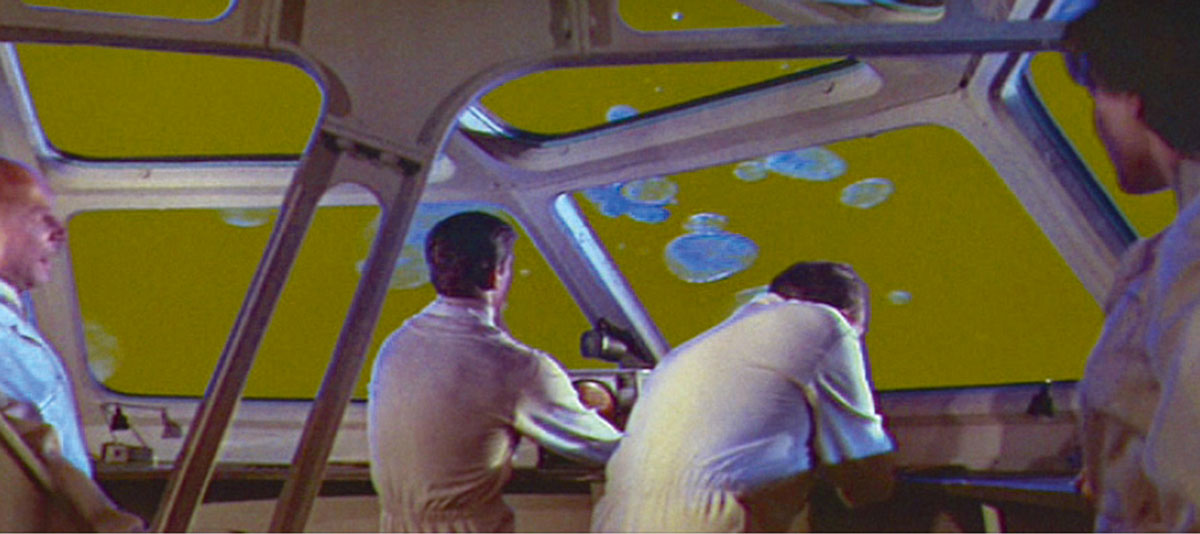
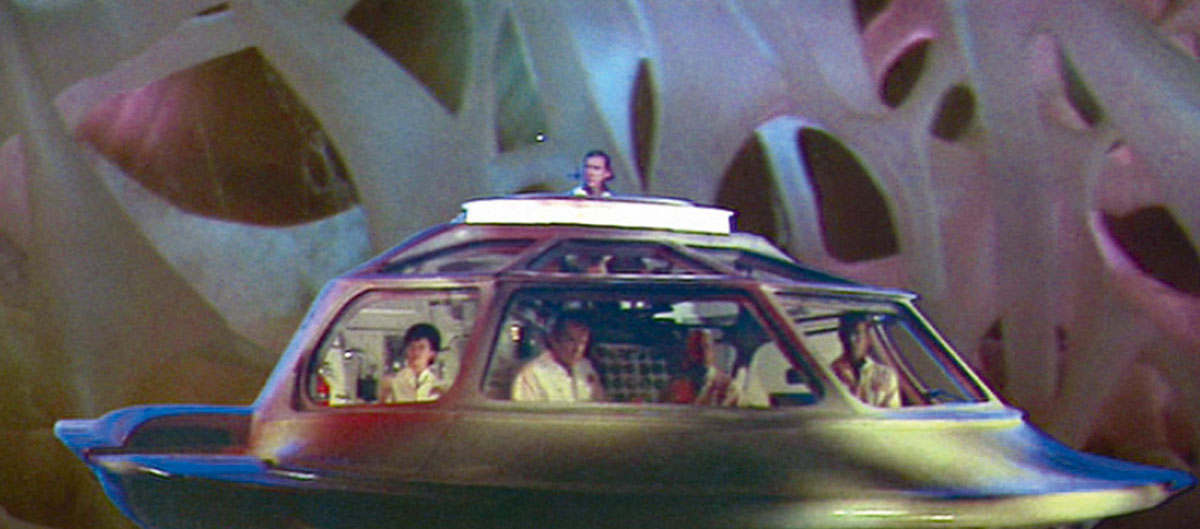
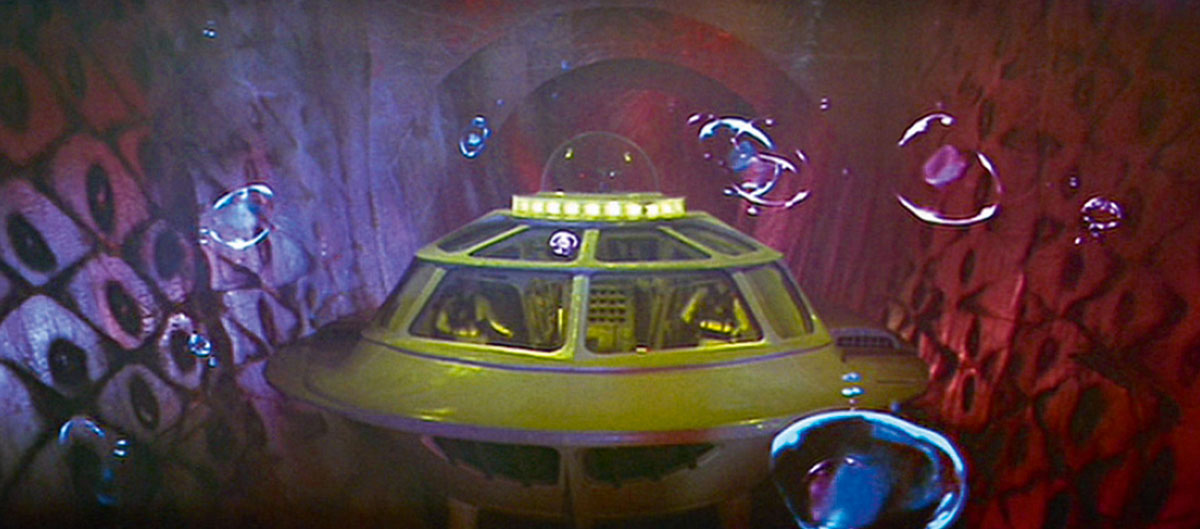
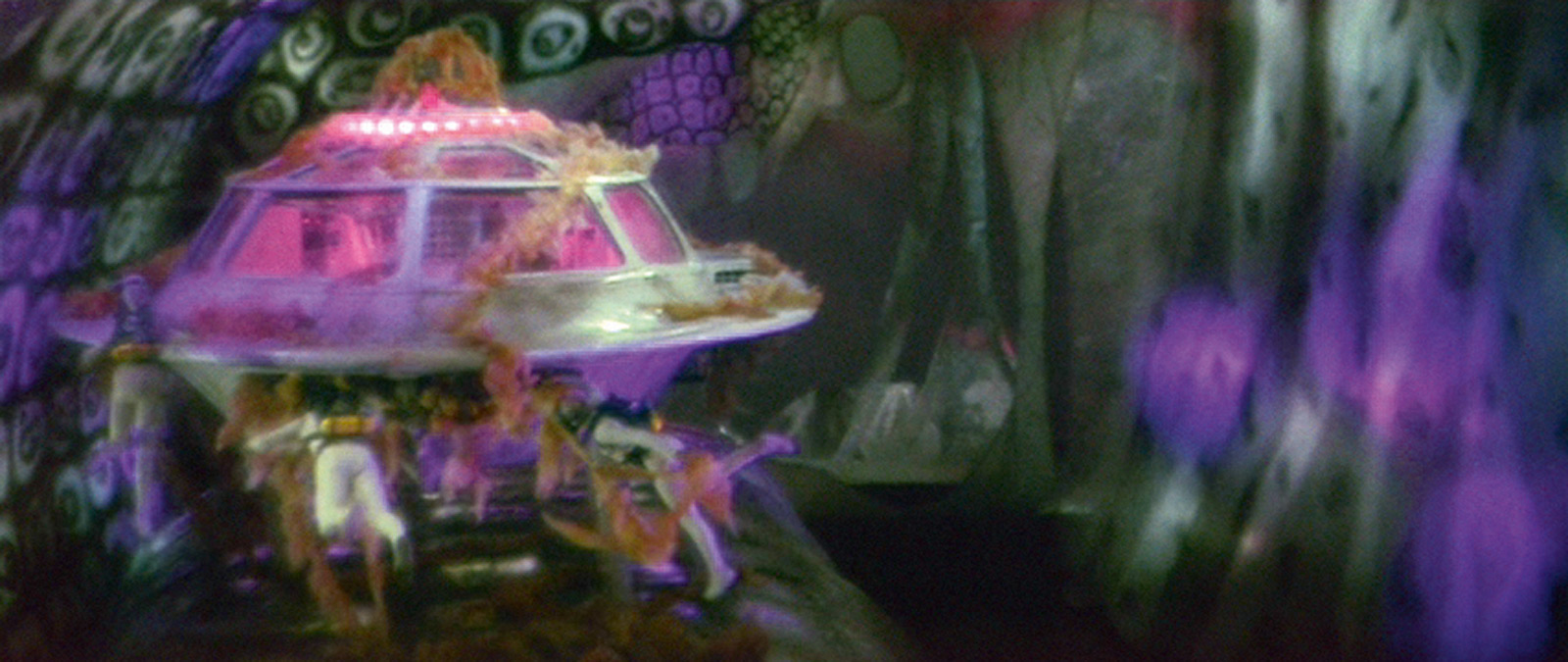
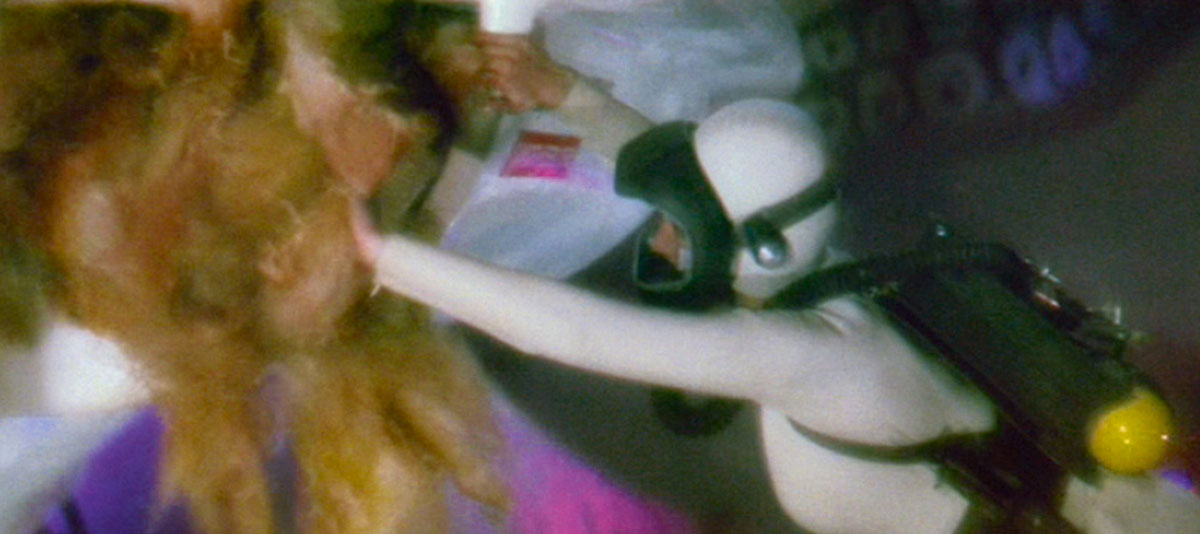
In this regard, it is useful to consider Powers of Ten alongside a Hollywood science-fiction movie that was made in 1966, two years before Rough Sketch was filmed. This production, Fantastic Voyage, is an extremely explicit example of the collapse of the broader geopolitical antagonisms of the period into the scale of the microscopic, the contest for the domination of which is the fulcrum around which the plot turns.[12] The story takes place against the background of research into miniaturization technologies, with the US and the “other side” simultaneously developing competing programs. When a scientist working for the rival program defects, he is attacked, with the result that a blood clot forms in his brain. In order to operate on it, a nuclear submarine-cum-spacecraft (appropriately called the Proteus) is shrunk, together with its crew, which includes an eminent brain surgeon, the American agent that aided the defector, and—it turns out—a spy who, unfortunately for him, happens to suffer from claustrophobia. In a kind of premonition of nanotechnology, the submarine and its crew are injected into the bloodstream of the comatose scientist, their mission being to navigate to the brain and destroy the blood clot with a laser. On their journey, the crew has to survive many perils, including the loss of their vessel’s oxygen reserves, which they are able to refill using the patient’s lungs. They also have to resist attacks by the body’s immune system, whose antibodies in this context appear as “alien beings,” and, of course, the inevitable assault of that other “alien,” the spy in their midst. Thus, the interior of the body comes to be a kind of inner space in which a narrative of contest and conquest, and—in a sense—a battle for political subjectivity, is played out (the mission being in effect to “liberate” the defector, to restore his consciousness by dissolving a blockage in his brain). At one point, soon after entering the patient’s bloodstream, the brain surgeon, Dr. Peter Duval, declares, “The medieval philosophers were right. Man is the center of the universe. We stand in the middle of infinity between outer and inner space, and there’s no limit to either.” This statement, however contradictory it might be, is surely as apt a description of the basic visual structure of Powers of Ten as it is of Fantastic Voyage.
In Rough Sketch, the voice of the commentator is that of a woman, whose affectless monotone Paul Schrader described as “a dispassionate female voice—a robot stewardess,” the latter phrase implying that the source of the voice is travelling with us, perhaps much in the same way as did the onboard computer HAL in Stanley Kubrick’s 2001: A Space Odyssey, which was released the same year.[15] At one point in his article, Schrader in fact explicitly compares the Kubrick and Eames films. Here, at least, we have a response to the Rough Sketch commentary that clearly places it with “one foot in the image”—and indeed for Chion, the voice of HAL, which is “ubiquitous, all-seeing, all-knowing,” is markedly acousmatic. He describes the disconnection of the circuits of the computer, during which it slides from subject to non-subject, from “a living acousmêtre to an acousmachine,” as the “most moving acousmêtre death in cinema.”[16]
With the 1977 film, however, the voice’s status has become more complicated and difficult to determine. On one hand, the commentary acquires a new “placefulness,” appearing locational in a way not evident in the earlier film. Yet, on the other, its effects continue to depend upon the atopicality of the acousmatic voice, the sense of which is intensified by its relation to the constant and extreme motion of the image: as the film goes “everywhere,” so too it is accompanied, or even led by, the tutelary voice, which is always epistemologically in advance of our vision. It is from the holding together of these two registers that much of the rhetorical effect of Powers of Ten issues. Unlike the “robotic” female of Rough Sketch, the recognizably accented male commentator in the 1977 version irresistibly connotes the voice of “mission control” and hence a geographical, national, and political place or source toward which everything that is familiar in the voice points back. Yet this is a placeful voice that has become ubiquitous, an accompaniment that retains its even measure despite the ever-changing visual acceleration. At once both located and seemingly everywhere, this equivocality then permits the voice to exert a powerful domesticating effect across the vast dimensional range of the film that it acousmatically encompasses. Part and parcel of this are the powers of panopticism and omniscience that, as Chion shows, are conventionally ascribed to the acousmêtre, whose condition as a being both “involved in” the image but yet magically beyond it gives it a special vantage point. “The acousmêtre is all-seeing,” Chion declares, “the fantasy of the total mastery of space by vision.”[17] And—notwithstanding the horizons of knowledge that are declared at the film’s limits—it is exactly this that, for its Cold War cultural context, the voice-image complex of Powers of Ten seems to depict.
See press about “Adventure on the Vertical” in the Huffington Post.
- William Gaunt, “Introduction,” in W. Watson-Baker, World Beneath the Microscope (London and New York: The Studio, 1935), p. 9.
- Gideon Mantell, Thoughts on Animacules; Or a Glimpse of the Invisible World Revealed by the Microscope (London: John Murray, 1846), p. 7.
- On microscopy and imaginaries of travel, see Barbara Maria Stafford, Body Criticism: Imaging the Unseen in Enlightenment Art and Medicine (Cambridge, Mass. and London: MIT Press, 1993), pp. 342–349.
- Philip and Phylis Morrison, “A Happy Octopus: Charles and Ray Learn Science and Teach it with Images,” in Donald Albrecht et al., The Work of Charles and Ray Eames: A Legacy of Invention (New York: Harry N. Abrams, 2005), p. 108.
- Donald Albrecht, “Design is a Method of Action,” in Donald Albrecht et al., The Work of Charles and Ray Eames, op. cit., p. 32.
- Hélène Lipstadt citing George Nelson in “Natural Overlap: Charles and Ray Eames and the Federal Government” in Donald Albrecht et al., The Work of Charles and Ray Eames, op. cit., p. 161.
- Philip Morrison cited in Pat Kirkham, Charles and Ray Eames: Designers of the Twentieth-Century (Cambridge, Mass. and London: MIT Press, 1995), p. 353. Paul Schrader, “Poetry of Ideas: The Films of Charles Eames,” Film Quarterly, vol. 23, no. 3 (Spring 1970), p. 11.
- J. G. Ballard, “The Voices of Time,” in The Voices of Time (London: Victor Gollancz Ltd., 1985), p. 39.
- Alan Lightman, “A Sense of the Mysterious,” in Donald Albrecht et al., The Work of Charles and Ray Eames, op. cit., pp. 122–123.
- Charles Eames claimed that their films didn’t have plot, and that “in most of them it is structure that takes [its] place.” But in Powers of Ten, the former seems more to conjure the latter than to displace it. Paul Schrader, “Poetry of Ideas,” op. cit., p. 15.
- Robert Hooke, Micrographia: Or Some Physiological Descriptions of Minute Bodies Made by Magnifying Glasses with Observation and Inquiries Thereupon [1665] (Lincolnwood, Illinois: Science Heritage, 1987), no pagination.
- In his article, Schrader in fact describes Powers of Ten as a “fantastic voyage”; Paul Schrader, “Poetry of Ideas,” op. cit., p. 11. Richard Fleischer, dir., The Fantastic Voyage (Twentieth Century Fox, 1966).
- Michel Chion, The Voice in Cinema (New York: Columbia University Press, 1999), p. 21.
- Ibid., p. 24.
- Paul Schrader, “Poetry of Ideas,” op. cit., p. 11.
- Michel Chion, op. cit., pp. 44–45.
- Ibid., p. 24.
Mark Dorrian is professor of architecture research at Newcastle University and co-director of the design atelier Metis. His co-edited book on aerial imagery, Seeing From Above, will be published by I. B. Tauris in 2012. He is currently working on air conditioning.
Spotted an error? Email us at corrections at cabinetmagazine dot org.
If you’ve enjoyed the free articles that we offer on our site, please consider subscribing to our nonprofit magazine. You get twelve online issues and unlimited access to all our archives.